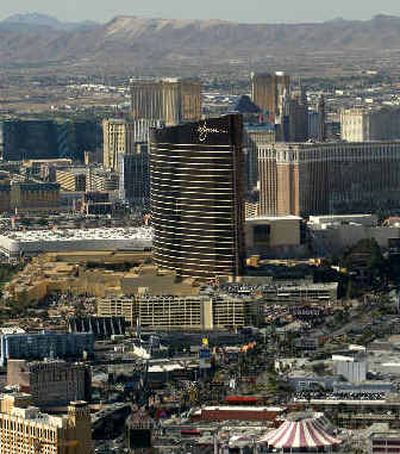Casino makes big statement

LAS VEGAS — For five years, casino developer Steve Wynn has labored over his latest creation, the $2.7 billion Wynn Las Vegas, forbidding photographs of the interior and keeping most of its design aspects secret.
The wait to see Wynn’s much-hyped design was ending early today as the towering, bronze glass hotel-casino with 2,700 rooms made its official debut, perhaps bringing with it a new era of architecture that could reshape the city.
“I think this redefines what a large-scale luxury resort can be,” said Ron Kramer, president of Wynn Resorts Ltd., the property’s parent company. “Whatever the future of Las Vegas is, it starts April 28, 2005.”
Ultimately, the public will pass judgment on Wynn’s curvy property, but a tour of Wynn Las Vegas reveals an intriguing design that differs in many ways from his previous hotel-casinos such as the Bellagio, The Mirage and Treasure Island. Wynn lost control of those properties when Mirage Resorts was acquired by billionaire investor Kirk Kerkorian in 2000, creating MGM Mirage Inc.
Along with Wynn Las Vegas, the gambling tycoon is building Encore, an adjacent $1.4 billion hotel-casino scheduled to open in 2008. Wynn is also erecting a $700 million casino in Macau and is bidding on one in Singapore.
Shares of Wynn Resorts fell $1.66, or 3 percent, to $54.69 on Wednesday, extending a slide from above $76 a share a month ago. In an investor’s note Tuesday, David Anders, a Merrill Lynch gambling analyst, downgraded Wynn’s stock from neutral to sell.
While the days of dark, smoky casinos have long passed, Wynn has finally taken full advantage of the sun that illuminates this desert valley. Light pours into many of its spaces, providing a sense of openness.
Vibrant and distinct colors are everywhere from the powerful red carpets with purple and green to the chocolate-brown ceilings.
Wynn Las Vegas, located on the northern end of the Las Vegas Strip, also embraces nature.
He has built an atrium that connects the property’s two main entrances filled with an array of mums and orchids. His restaurant, Okada, boasts an authentic Japanese garden with a pond teeming with vegetation found traditionally in Asia.
Other restaurants have patios facing a “Lake of Dreams,” a watery area hidden behind a mountain of evergreen trees.
Wynn is counting on the restaurants to help generate a quarter of a billion dollars in revenue. He has landed top-notch chefs to work behind the stove instead of courting celebrity chefs more interested in television shows and cookbook signings than their cuisine.
Elizabeth Blau, Wynn’s executive vice president of restaurant marketing and development, said the food will live up to the hype, surpassing anything she and Wynn did at the Bellagio.
The restaurants, she said, will make a “giant statement.”
Two years ago, Wynn changed the casino’s name from Le Reve to Wynn Las Vegas, believing the latter was more marketable. But Le Reve didn’t totally disappear: It’s the title of his impressive art collection that the property will house, including its former namesake by Picasso, Le Reve.
Perhaps most striking about Wynn Las Vegas is that the traditional casino layout has been scuttled. The casino is no longer centerstage, dominating a visitor’s attention and wallet. Many of the high-end restaurants and upscale shops can be reached without traversing the casino floor.
The place also feels deceptively small. Getting from one end to the other isn’t like trekking across Caesars Palace or MGM Grand. But this isn’t a boutique hotel, either. People clutching maps still had to ask for directions.